In 1891, three Sisters of the order of St. Joseph, dedicated to the service of God, began a venture that led from a converted private house equipped with 19 beds for the sick and indigent, irrespective of race, religion or color, to what we came to know as St. John’s Queens Hospital. What the founding Sisters of St. Joseph saw as their mission back then remained a constant throughout the hospital’s history and was the foundation of its modern day mission and values.
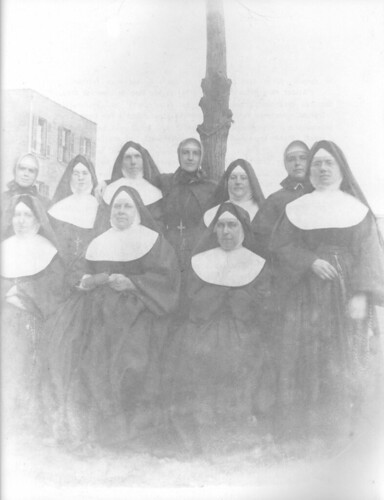
The founding Sisters of St. John's
The pilgrimage of healing began when Bishop John Loughlin, Ordinary of the Diocese of Brooklyn, requested the Sisters of St. Joseph “to attempt a hospital.” For this purpose, Bishop Loughlin purchased 29 lots, the deed to which he gave to the Sisters. The property was located in Long Island City at the intersection of Jackson Avenue and 12th Street, which was later renamed 45th Avenue. Today, this piece of land is occupied by the Citicorp building. At that time the property contained a partially constructed brick building and four detached wood frame houses.
Voluntary labor provided by employees of the Long Island Railroad and local factory workers enabled these structures to be combined into a two-story hospital building and a hospital convent for the sisters in only two months.

The first St. John's was opened in LIC in 1891.
Tradition holds that Sr. Mary David, a pioneer in the original building, had 50 cents in liquid assets when she opened the hospital. The sisters begged alms from the community and did so into the next century. A sugar refinery and a soda water plant donated their products while a kitchen equipment warehouse supplied all of the cooking utensils and dishes. The first concerted fund raising campaign was started as early as 1892, when a merchant on Grand Street donated a gold watch for the first raffle.
The hospital was opened for patients on May 23rd, 1891 with six beds in the basement, thirteen beds on the upper floors and an operating room on the second floor. It was the first institution for the care of the sick and infirm in the northwest area of Queens.
Medical care was provided in the first year by Dr. Hughes of Williamsburg, Dr. Frank Valentine of the Long Island City Railroad and Dr. James Kennedy of Long Island City.
The first patient, Ann Schulster of Astoria, was a female who was diagnosed with a fractured tibia. She was hospitalized for 39 days. Her discharge status was described as “cured”.
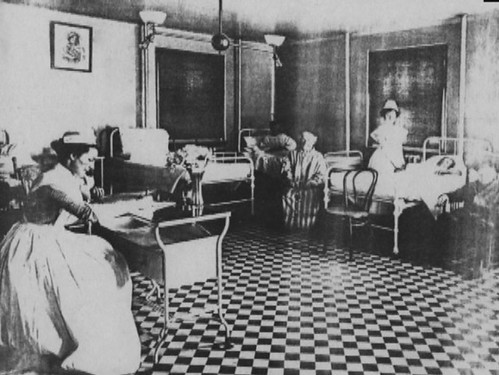
An early hospital ward
The first annual report states that from May 1st, 1891 to May 1st, 1892, 145 medical patients were admitted. The leading medical diagnoses were pneumonia, rheumatism, typhoid fever, bronchitis, chronic alcoholism, Bright’s disease and heart disease. During this same period, 181 surgical patients were admitted. The leading surgical diagnoses were fractures, burns, gun shot wounds and ulcers. The annual report proudly boasted that the hospital had furnishings that included “iron cots with woven wire springs and hair mattresses.” Hospital meals were served 3 times a day with gruel at mid morning and beef-tea or beer in the afternoon. Hospital billing rules in force at that time stated that “patients without means will be treated free, those able to pay will be charged $1.00 a day.”
The geographic location soon proved to be an ideal setting for a health care facility since many were injured in the rail yards and other nearby factories. In August 1892, the “Berlin Disaster” occurred when a train coming from the racetrack collided with the Manhattan Beach train in the village of Berlin just outside Long Island City. Every available vehicle was pressed into service to carry burned and injured patients to St. John’s. The only positive aspect of this accident was the awareness that an ambulance was a great need. The deficiency was remedied when the first ambulance was put into use on September 26th, 1892 as a result of fund raising by Joseph Silverstone, Esq.
On June 4th, 1897, the first baby born in the hospital, John Setti, was registered as “Saint John Setti” at the request of the nuns on the hospital staff. Mr. Setti grew up to become a noted architect in Hudson County, New Jersey.
As time went by, hospital admissions grew steadily and bed capacity grew to 80. By 1899, 1,966 patients were admitted. It soon became apparent that larger facilities were needed. Plans were drawn to erect a four-story building and wing on the site. Total cost was estimated at $100,000. The new hospital opened on January 9th, 1900 and a training school for nurses was added in February of that year.
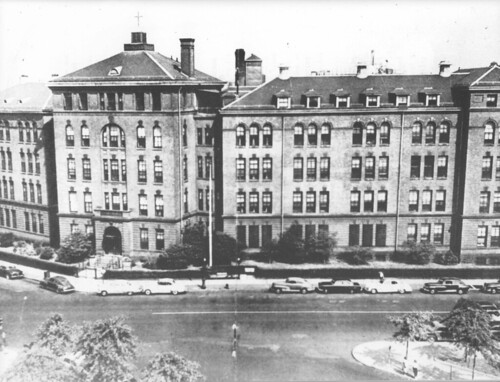
The second St. John's in LIC was opened in 1900
In 1916, St. John’s celebrated its 25th anniversary. At that time, Burke Cochran, an eminent orator of the World War I era, declared that, “when Sister Mary David opened the hospital, she had more than 50 cents – she had the promises of God and those promises are never broken.”
During the Depression years, St. John’s cared for increasing numbers of the economically disadvantaged and therefore the hospital’s reliance on charity and goodwill increased. Because of a sense of pride in its hospital, the community responded to its needs.
With advent of Franklin Roosevelt’s New Deal and the passage of the Social Security Act, it became necessary to help patients obtain entitlements and St. John’s started its own Social Service department.
The involvement of the United States in World War II in 1941 coincided with the 50th anniversary of the hospital. Many affiliated with the hospital served their country. Ninety-five percent of all nursing students were members of the Cadet Nurse Corps. Many graduates became flight nurses.

St. John's Nursing School students, 1970
By 1948, statistics indicated that St. John’s provided more free care than any other hospital in Queens. It received no payment for 67% of treatments rendered.
In 1960, it was recognized that the physical plant of the hospital was ill equipped to meet the demands of new technologies and practice. Because renovations would necessitate closing major portions of the building, the Board of Trustees decided to relocate. Horace Harding Hospital, a six story proprietary facility located on Queens Boulevard in Elmhurst, was purchased. St. John’s re-opened in Elmhurst in 1961. The new facility permitted an increase in bed capacity from 205 to 231, an increase in the number of operating rooms from four to eight, and the addition of a 35-bed maternity ward. In 1964, a new wing was dedicated which provided additional space for emergency services, outpatient clinics, physical therapy, a chapel, a medical library, and additional semi-private and private rooms.
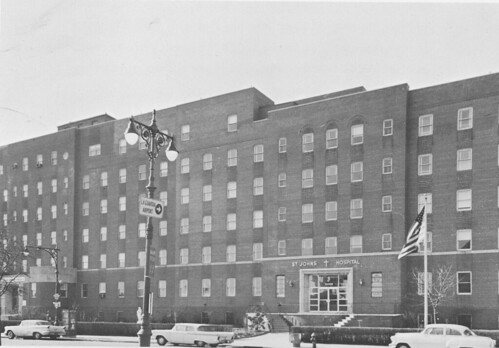
The third St. John's in Elmhurst at the site of the former Horace Harding Hospital
About this time, Sr. Thomas Francis, who had begun to work at St. John’s in 1944, became the executive director of the hospital. Being not only an administrator but also a registered nurse, she understood the concerns of the staff and the needs of the community. Because of this she was beloved by the staff and was effective in reaching out to the community – making them feel that St. John’s was their hospital. The community in return, gave of their time, talents and services to the hospital as volunteers.

Sr. Thomas Francis
In 1965, St. John’s responded to the greatest number of ambulance calls in the county. Nearly 20,000 patients were seen in the Emergency Room and the number of inpatients grew to the extent that plans were being made to increase bed capacity once again.
In 1967, the Catholic hospitals of the diocese were consolidated into a central system and the hospital became “St. John’s Queens Hospital – a division of the Catholic Medical Centers of Brooklyn and Queens.”
In 1968, under the directorship of Dr. Nicholas DeFrancis, a four-bed Coronary Care Unit opened and in 1971 a sixteen-bed Intensive Care Unit was added. Dr. DeFrancis was an innovative physician. St. John’s was one of the first hospitals in the metropolitan area to have capabilities to do bedside right heart catheterization. To expedite care of critically ill patients, the intensive care unit had its own mobile dialysis machine and had facilities to do in-unit blood and urine testing. Dr. DeFrancis also installed a trans-telephonic monitor so that he was able to monitor EKGs and patient data from his office, which was located several miles from the hospital. The capabilities of the critical care units were equal only to the most sophisticated and advanced units in the country. In 1971, the first pacemaker clinic on Long Island opened at St. John’s.
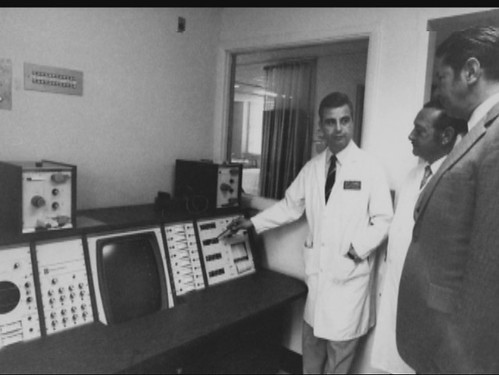
Dr. Nicholas DeFrancis was a visionary physician.
As the hospital began to be recognized as a center of excellence, a medical residency rotation was instituted. St. John’s had now become a teaching hospital.
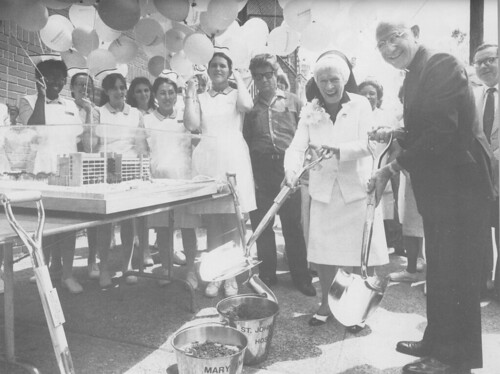
Sr. Thomas Francis and Bishop Francis Mugavero break ground on the expansion of St. John's in 1980
The 1980s saw an expansion and renovation of St. John’s. Every room in the hospital was modernized. A new wing was added which was called the Sister Thomas Francis Pavilion. It housed a new emergency room, the outpatient clinics, the radiology suite, the critical care units, the 10-bed renal dialysis unit and an enlarged operating suite. The old part of the building received a new façade that not only altered its appearance completely but also provided space for a modern lobby and new patient rooms.
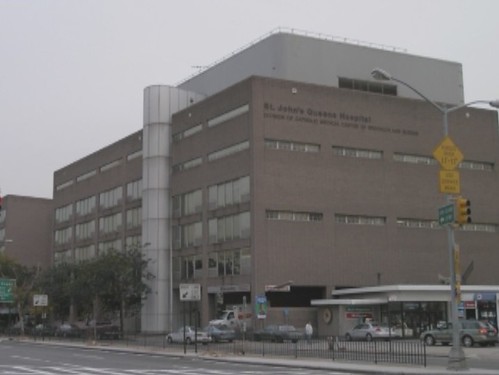
The hospital after its renovation
Sister Thomas Francis retired in 1982 and was succeeded by Jim Foy and in 1984 the leadership was passed to Sister Helen Faulds.
Sister Helen oversaw preparations for the celebration of the 100th anniversary of St. John’s. At that time she published a booklet on the history of St. John’s Hospital that was subtitled “A pilgrimage of healing (1891-1991).” The anniversary was observed on April 23rd, 1991 with a celebration of a Mass of Thanksgiving. In attendance were many members of the Sisters of St. Joseph, representatives from community organizations and businesses and relatives of Sr. Mary David, who founded St. John’s in 1891. Representative Geraldine Ferraro attended. Claire Shulman, Borough President, presented a plaque designating March 31st, 1991 as “St. John’s Day” in Queens.
In 1995, an increase in the population of the neighborhood combined with a lack of space at St. John’s necessitated the relocation of its outpatient department. The St. John’s Family Health Center, located ½ mile from the hospital on Queens Boulevard, was officially opened on October 10th, 1995.
Starting in 1998, a magnetic resonance imaging suite was added. A high tech nuclear cardiology service was established. A completely digital echo lab, a state of the art cardiac catheterization lab, a renovated ultramodern surgical suite and an expanded and enhanced pediatric area soon followed.
In 2000, in order to further enhance its ability to provide outstanding care for patients and to achieve economy of scale, St. John’s Queens Hospital and the other Brooklyn and Queens Divisions of the Catholic Medical Center made the decision to merge with St. Vincent’s Hospital in Manhattan and became St. Vincent’s Catholic Medical Centers. In hindsight, this was a very unfortunate choice.
Wyckoff Hospital bought St. John’s Queens and Mary Immaculate Hospitals for $41.5 million in late 2006 from St. Vincent's Catholic Medical Centers, which had filed for Chapter 11 bankruptcy in 2005. Wyckoff created a separate corporation called Caritas to oversee the hospitals. Caritas completely mismanaged them and filed for bankruptcy in early February of this year.

JPCA joins St. John's protest on February 13th, 2009. That night at midnight, ambulances were no longer allowed to bring patients to St. John's emergency room.
Despite multiple protests from Queens Boulevard to City Hall to Albany, and pleas to the State Legislature, Governor Paterson and Mayor Bloomberg, our elected officials made the decision to not bail out Caritas.
On February 14th at midnight, the hospitals stopped accepting patients via their emergency departments. At midnight on March 1st, both hospitals were completely closed down. The closure left 2,500 employees out of work and removed 455 sorely needed hospital beds from the borough of Queens.
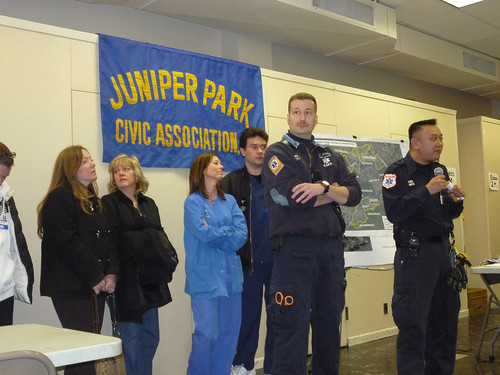
St. John's staff spoke at JPCA's February 2009 meeting
The estimated 200,000 patients that were annually served by these hospitals must now seek medical care elsewhere and ambulance response times will increase, leaving our families, neighbors and us more vulnerable to sickness and death. We urge Attorney General Andrew Cuomo to investigate how and why this hospital that served our community for 118 years was completely destroyed in less than 30 days – without a mandatory impact statement being filed and at lightning speed. Someone is benefiting from this at our expense and we must ask who, how and why and hold them accountable.
History adapted from “St. John’s Queens Hospital, a Pilgrimage of Healing (1891-1991),” by Sr. Helen Faulds, C.S.J., 1991.
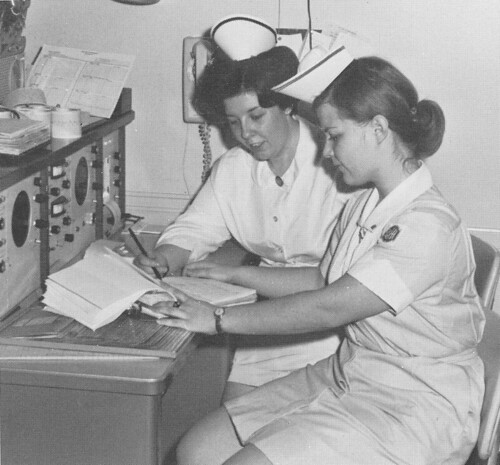
Catherine Wilkinson during a nursing school rotation in 1971.
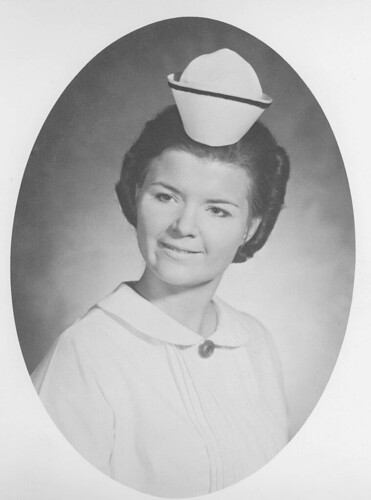
Catherine Wilkinson's 1971 nursing school graduation photo. (Catherine is the mother of JPCA Secretary Christina Wilkinson.)



